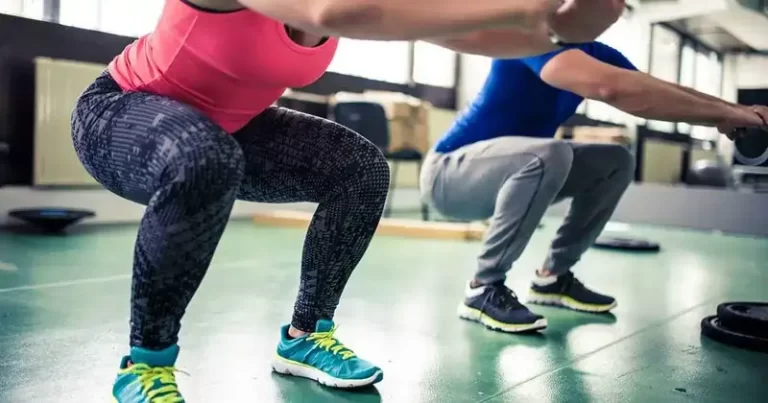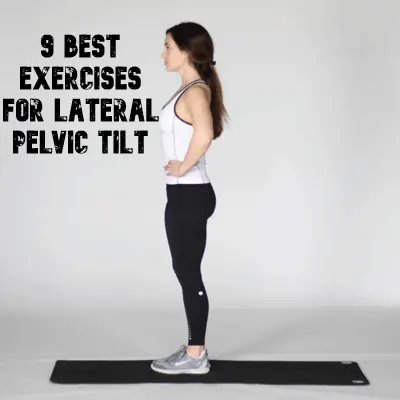Antenatal Exercises
Introduction:
Prenatal exercise, sometimes referred to as Antenatal Exercises or pregnancy exercises, is a kind of exercise designed specifically to keep pregnant women healthy and prepare their bodies for labor and delivery.
Antenatal exercises are designed to avoid pregnancy-related disorders by increasing the pregnant mother’s physical and mental well-being in preparation for labor. Low-impact aerobic exercises and stretching are frequently included.
During the first trimester of pregnancy, some changes in the body take place, including nausea, increased release of the relaxin hormone, morning sickness, and tiredness or low energy. Exercise strengthens the mother’s energy and mood and helps her manage these changes.
The goal of antenatal exercises is to avoid pregnancy-related problems while improving the physical and mental health of a pregnant woman in preparation for labor.
Antenatal Exercise Benefits:
Exercise during pregnancy may help pregnant women maintain their fitness, manage their weight, and feel happier, among other health benefits. Pregnancy-related issues including pre-eclampsia and hypertension caused by pregnancy can also be prevented by engaging in regular exercise during pregnancy.
Exercising during pregnancy has several physical and mental benefits. Because you’re taking care of both yourself and your unborn kid, it might help you handle some effects of pregnancy and lift your spirits.
Regular exercise during pregnancy has several advantages, including:
- Increases the strength of muscles
- Increased level of fitness
- Decreased pelvic and back pain
- Strengthening the core
- Prevents pregnant women from gaining excessive weight.
- Lessens morning sickness.
- Lessens stress, worry, and insomnia.
- Support better posture
- Promotes relaxation
- Stress relief
- There is a decrease in other pregnancy-related problems such as tiredness, cramping in the legs, edema in the limbs, etc.
Exercise precautions during pregnancy:
Even while the majority of activities are safe, some poses and motions might be uncomfortable or dangerous for pregnant women. As directed by your physician or physical therapist, general precautions include;
- Exercises must be performed closely and supervised.
- It should normally be possible for pregnant women to have conversations while working out. You are most likely exercising too hard if you start to get out of breath while speaking.
- Try to be active every day; 30 minutes of walking can be sufficient, but even if you are unable to complete that, any activity is better than none at all.
- Stay away from sudden changes in posture.
- Breathe deeply, and work at your own time and capacity.
- Don’t put yourself through too much.
- Depending on your physical state, your physical therapist may alter the activity.
- Staying hydrated is important, particularly before, during, and after exercises.
- Follow the proper warm-up and cool-down protocols.
- To prevent getting too hot, work out in a room with a controlled temperature.
- Stay away from exercising outside when it’s hot or rainy.
- Do not lie flat on your back or stand immobile as much as you can.
- Take care to empty your bladder before working out.
Cardiovascular Exercise:
- The pre-pregnancy fitness level will be evaluated to determine the workout’s intensity.
- Any cardiovascular activity walking, swimming, hiking, etc. should be chosen with one’s interests in mind.
- Walking can therefore be done safely for 20 to 30 minutes, three to four times a week, considering it is the only aerobic exercise a person does.
Strengthening Exercises:
Wall push-ups
- Face a wall as you stand.
- Keep your knees at a comfortable distance from one another.
- Raise your hands shoulder-high and position them against the wall, a little wider than shoulder-width apart.
- Tilt your body slowly and flex your elbows until your chin makes contact with the wall.
- Maintain a straight back.
- Hold this position for a few seconds.
- Then return to your neutral position.
- Then relax.
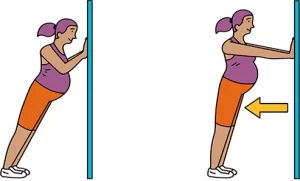
Bridging
- When you have a mat, place it in a visible area of the floor and lie on your back.
- Your hands should be at your sides while you bend your knees and place your feet flat on the floor beneath them.
- By squeezing your lower back toward the floor, you can tighten your buttocks.
- In order to align your knees and shoulders, lift your body upward.
- Pull your belly button back toward your spine while providing core pressure.
- Hold this position for a few seconds.
- Then return to your neutral position.
- Then relax.
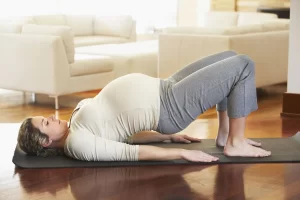
Lunges
- This exercise gave additional attention to the gluteus, hamstrings, and quadriceps.
- Straighten up and move forward a step.
- To load your glutes and hamstrings instead of your quadriceps, lower yourself now and attempt to keep your front leg vertical.
- Maintain a straight posture by pressing your leg down.
- Hold this position for a few seconds.
- Then return to your neutral position.
- Then relax.
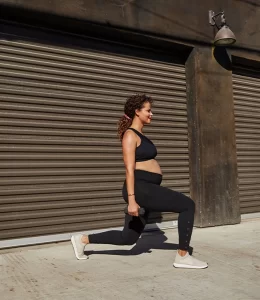
Pelvic tilt
- Bend your knees and lie down to make yourself comfortable.
- As if to prevent yourself from farting and urinating, tense and squeeze the muscles surrounding your lower abdomen.
- Take a deep inhale to tighten your muscles, then release it when your muscles relax.
- Try to complete this exercise fast at the beginning.
- Afterward, proceed gradually, maintaining the squeezes for as long as you can until relaxing.
- Then return to your neutral position.
- Then relax.

Squat
- Gluteus maximus is the main focus of this excellent lower extremity exercise.
- Set an exercise ball between the bottom of your back and the wall’s surface while standing against it.
- Put your hands on your hips.
- Squat while letting out a breath, being careful that your knees don’t touch your toes.
- Hold this position for a few seconds.
- Apply pressure and straighten your legs as you rise.
- Maintain stability.
- Then return to your neutral position.
- Then relax.
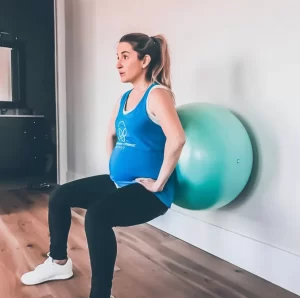
Stretching exercises:
Pectoral stretch
- In addition to helping to open up the chest, this exercise prevents round shoulders.
- The ball should be moved into a corner or near the wall.
- Maintaining the back of the ball, take a comfortable seat.
- Your hands should be at your sides or locked back to your head.
- Let your elbows spread out and open your chest while keeping your head on the ball.
- Hold this position for a few seconds.
- Then return to your neutral position.
- Then relax.
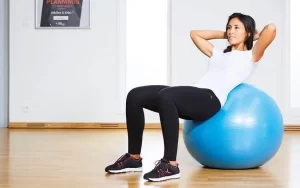
Calf stretch
- Take a position facing a wall.
- Both hands should be on the wall for stability.
- Keep your leg straight as you move toward the wall until you’re experiencing a stretch at the back of it.
- Hold this position for a few seconds.
- Then return to your neutral position.
- Then relax.
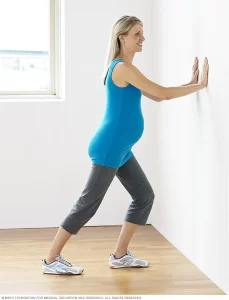
Hip Flexor Stretch
- Place one leg in front of you and kneel on the side that needs stretching.
- Place the hands on the front leg.
- Keep your back straight, contract your abdominal muscles, and move the affected leg forward.
- Avoid arching your back.
- A slight stretch should be experienced in the front of the hip.
- Hold this position for a few seconds.
- Then return to your neutral position.
- Then relax.
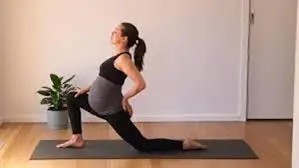
Butterfly Pose
- Position your legs in front of you while sitting on the floor or an exercise mat.
- With your left knee bent gently and your sole facing up, rest your left foot on your right thigh as near to your belly button as you can while maintaining a normal breathing pattern.
- If you’re having trouble arranging the leg this way, place the left foot on the floor close to your right thigh so the sole faces the thigh too.
- Gripping the toe of your left foot with your right palm, gently press it up and down.
- Then return to your neutral position.
- Then relax.

Seated Straddle
- With both legs spread wide, straighten your feet.
- To help with spine straightening, press your hamstrings and pelvis into the floor.
- Walk your hands out in front of you or remain in this position if it is sufficient to stretch the backs of your legs.
- Hold this position for a few seconds.
- Then return to your neutral position.
- Then relax.

Hamstring stretch
- One leg should be straight out while you sit on the floor.
- The second leg should be bent at the knee, and the sole of that foot should be placed against the opposing inner thigh.
- Stretch your arms out and flex your waist as much as you can to extend your arms forward over the straight leg.
- Hold this position for a few seconds.
- Then return to your neutral position.
- Then relax.

Breathing exercise:
Breathing exercises to reduce labor pain. Before inhaling, it is recommended to exhale.
Abdominal breathing
- Belly breathing involves sitting with your legs crossed and in a very comfortable position.
- Relax all of your body at once.
- One hand should be placed on your tummy, and the other over your chest.
- Hold on to your deep breathing.
- As you count, take a deep breath out of your lower abdomen, bringing in fresh air.
- Don’t release your breath too soon.
- Continue at a constant modest pace.
- Just spend a few minutes doing it twice a day.
- Then return to your neutral position.
- Then relax.

Lower costal breathing
- Touch the lower rib cage with your hand.
- As you take a breath via your nose, let your chest grow.
- Hold this pose for a few seconds.
- Then exhale gently through your mouth.
- Then return to your neutral position.
- Then relax.

Exercises Particular to the Third Trimester:
- Before beginning the duck walk, hold your arms at your sides and stand with your feet wide apart. To prevent accidental harm to your back and abdominal muscles, maintain a tight posture during the workout.
- Then, as if sitting on a chair, one ought to lower one’s body from the hips, ensuring that one’s heels bear the weight.
- This will not cause damage to the knees. To keep your balance during the duck walk, it can be useful to hold your hands in front of your chest.
- Once in the correct position, take a few steps forward at a time while keeping your squat posture, then turn around and return to your starting position gently. It is advised that people lean forward and maintain their weight on their heels to maintain their balance when performing the duck walk exercise.
- Using an elastic band around the ankles at the beginning of the workout might make the duck walk exercise more challenging. One new workout method called the duck walk exercise, involves squatting even lower till the person is nearly sitting on their heels.
- During pregnancy, particularly in the latter few months, women can perform the duck walk exercise. In addition to strengthening the thighs, it will make it easier for the baby’s head to move downward. Labor and delivery are normal and simple with Duck Walk.
Things to Consider in Everyday Life:
- To raise something, contract your abdominal muscles to maintain your lower back straight, bend your knees with the strength of your thigh muscles, and then straighten your knee joints.
- Lying sideways with both legs hanging over the edge, push yourself upright by straightening both arms.
- Maintain a straight back and a firm abdomen while sitting or standing.
Pregnancy-related exercises to avoid:
Avoid sports and activities that are associated with or have a higher risk of;
- Basketball, soccer, martial arts, and other competitive sports that include contact or conflict.
- Hitting tools or hard projectiles, like in softball, cricket, or hockey.
- Downhill skiing, horseback riding, and skating are examples of the Falling.
- Heavy lifting.
Summary:
You may have an excellent opportunity to increase your level of fitness throughout pregnancy. Both you and your unborn child benefit from regular mild to moderate exercise. However, if you were not active before becoming pregnant, it is not recommended that you start doing intense activity.
In addition to basic strength and core stability exercises, you might want to start with low-impact exercise sessions like swimming, walking, and static cycling if you’re not used to working out.
You should begin by exercising continuously for 15 minutes four times a week, then progressively build to 30 minutes per day. Avoid engaging in any activity that makes you feel extremely uncomfortable.
FAQ:
What separates prenatal exercise from postnatal exercise?
Women engage in antenatal exercises throughout pregnancy, which provide them with a feeling of well-being and encourage circulation. Exercises that assist women return to their previous level of health after giving birth are known as postnatal exercises.
The antenatal period: what is it?
Three trimesters from the prenatal period. The care that is provided during the prenatal stage of pregnancy includes all trimesters, from conception to delivery. Pregnancy-related health problems or those that are expected to happen are the focus of antenatal care.
What is antenatal physical therapy?
Soft tissue massage, mild joint mobilization, manual therapy, lymphatic drainage, Kinesio taping, and other methods can all be used as antenatal treatments. Additionally, a women’s health physical therapist will create a prenatal exercise program for you.
When should a pregnant woman begin exercising?
You can start working out whenever you choose throughout your pregnancy. If you aren’t used to going out, you may begin with 10 minutes at a time and work your way up to 30 or 40 minutes. Avoid contact sports like football, baseball, or boxing and activities that could lead to falls like climbing or horseback riding.
What are antenatal care’s four components?
An important part of antenatal is promoting health and wellness through nutrition education and support, addiction prevention, family planning adoption, danger sign awareness, and birth preparation.
References:
- Darji, H., and Darji, H. Prenatal exercises, May 22, 2023. Prenatal workouts from Samarpan Physiotherapy Clinic: https://samarpanphysioclinic.com/
- Family Health Service: Prenatal physical activity. (n.d.). fhs.gov.hk/english/health_info/woman/14744.html in English
- March 7, 2024; Website, N. nhs.uk: Exercise during pregnancy. https://www.nhs.uk/pregnancy/maintenance/aerobic
- (n.d.) Department of Health and Human Services. Exercise and pregnancy. Better Health Channel. Workout and pregnancy: https://www.betterhealth.vic.gov.au/health/healthyliving
- Department of Physiotherapy for Pelvic Health, n.d. Antenatal-Booklet-2020.pdf: Antenatal exercise and advice booklet. https://kingstonhospital.nhs.uk/wp-content/uploads/2020/11/
- Image 1, I. E. Panel (2023, July 27). Pregnancy Symptoms, Nutrition, Exercise, and Other Things at 7 Months. Visit https://www.imumz.com/post/7-months-pregnant-symptoms-diet-exercises-and-more… Pregnancy symptoms for seven months: diet, exercises, and more https://www.imumz.com/post
- Image 2, N. Harris (2024, Sept. 10). Pregnancy-Friendly Pelvic Floor Exercises. parents. The best pelvic floor exercises to do while pregnant: https://www.parents.com/pregnancy/my-body/fitness
- Image 3, Denise. July 5, 2022. Maed. https://maed.co/7-exercises-for-your-first-trimester/ 7 Exercises For Your First Trimester Of Pregnancy
- Image 4, Safe Pregnancy Exercises to Address Pelvic and Low Back Pain | Orthopedic Blog | OrthoCarolina. (2022, January 3). https://www.orthocarolina.com/media/safe-exercises-to-combat-lowback–pelvic-pain-during-pregnancy OrthoCarolina
- Image 5, Exercises for Pregnancy Back Pain with Your Birthing Ball. (undated). The ball of birth. Back discomfort exercises you can do with your birthing ball during pregnancy: Visit https://thebirthball.com/pages/
- Image 6, (n.d.) Swiss Ball. indiamart.com. This product detail is available at https://www.indiamart.com/proddetail/swiss-ball-12184623855.html!
- Image 7, Stretching for pregnancy-related leg cramps. (n.d.). “Healthy lifestyle/pregnancy-week-by-week/multimedia/leg-cramp-stretch-during-pregnancy” (Mayo Clinic). https://www.mayoclinic.org/img-20005671
- Image 8, Stretches for Pregnancy with Low Back Pain | Loving Life Chiropractic (n.d.-b). Stretches for pregnancy that relieves low back pain: https://www.lovinglifechiropractic.com/
- Image 9, Prenatal yoga butterfly pose: https://www.todaysparent.com/pregnancy/being-pregnant/
- Image 10, S. C. Center (2017, March 31). Spine Correction Center of the Rockies | Fort Collins Back Pain | 10 Yoga Pose Ideas to Reduce Back Pain During Pregnancy. Rocky Mountain Spine Correction Center. The following yoga poses can help pregnant women with back pain: https://www.spinecorrectioncenter.com/10-yoga-poses-to-relieve-back-pain/
- Image 11, E. Bunch (1970, Jan. 1). The Top Pregnancy Stretches Suggested by Experts for Every Trimester. The results of Peloton. Stretches during pregnancy: https://www.onepeloton.com/blog/
- Image 12, Howald, K. (April 24, 2023). 360-degree diaphragmatic breathing: empowering and anticipating. Empowered and expecting. Breathing https://www.expectingandempowered.com/blog/2019/4/16
- Image 13, September 13, 2022: Bhirani, R. During pregnancy, use these breathing and postural methods to help manage dyspnea. www.healthshots.com/preventive-care/reproductive-care/5-methods-to-manage-shortness-of-breath-during-pregnancy/




